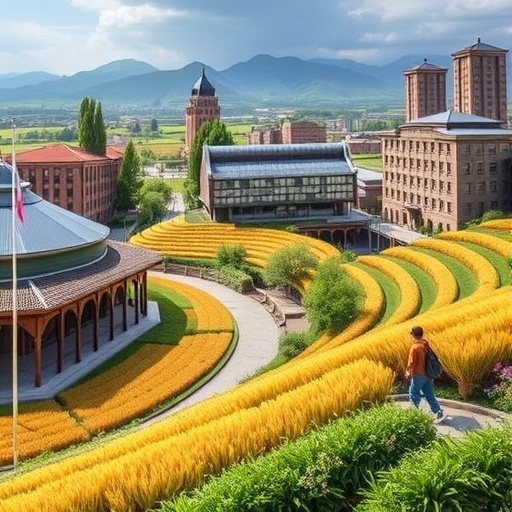In the rapidly evolving landscape of rural China, the traditional marketplaces known as “ganji” stand at the crossroads of cultural preservation and modernization. Recent research spearheaded by scholar M. Tan offers a compelling examination of these rural hubs, focusing on their dynamic transformations and enduring sustainability. This study, published in the International Journal of Anthropology and Ethnology, delves into the “ganji” marketplaces in Southwest China through the innovative lens of spatial practice, providing nuanced insights into how these spaces adapt and thrive amid socio-economic pressures.
The term “ganji” refers to rural trading markets that have historically played a pivotal role in the economic and social fabric of Chinese countryside life. Unlike urban commercial centers, these markets have traditionally operated on cyclical schedules—weekly or biweekly—forming stirring occasions for local villagers and traders to converge for commerce, social exchange, and community interaction. Tan’s research sheds light on the intricate spatial designs and practices that sustain these marketplaces, emphasizing their layered functionality beyond mere transaction points.
Central to the study is the concept of spatial practice, a theoretical framework popularized by Henri Lefebvre, which investigates how space is produced and reproduced through human activity. By applying this perspective, Tan articulates how “ganji” are not static but are continuously shaped by the behaviors, movements, and social rituals of their participants. This approach underscores the marketplaces as dynamic arenas where tradition interweaves with innovation, crafting a living, breathing cultural geography.
The research identifies several transformative forces acting upon “ganji,” including rural-to-urban migration, infrastructural modernization, and the influx of digital technologies. These changes pose both challenges and opportunities, prompting questions about the resilience and adaptability of “ganji.” Tan carefully analyzes how these marketplaces negotiate pressures from emerging retail patterns, such as e-commerce and centralized shopping centers, without losing their intrinsic cultural significance.
One of the key findings reveals that spatial practice within “ganji” enables their reinvention while maintaining continuity with historical customs. Vendors and visitors demonstrate fluid spatial arrangements that optimize social interaction, trade efficiency, and accessibility. This adaptability is often expressed through the temporary, modular setups characteristic of “ganji,” which facilitate the market’s capacity to recalibrate in response to environmental and economic shifts.
Moreover, the study explores how “ganji” serve as vital socio-economic nodes that foster community identity and mutual support. These marketplaces function as more than economic loci: they are imbued with social capital, where interpersonal relationships and trust networks are cultivated and reinforced. Such social dynamics contribute significantly to the marketplace’s sustainability, counterbalancing competitive pressures from more homogenized commercial formats.
Tan’s investigation further addresses policy implications, advocating for preservation strategies that recognize the value of “ganji” beyond their economic contributions. Emphasizing participatory planning approaches, the research suggests that empowering local stakeholders to actively shape marketplace evolution is crucial. This inclusive governance framework would safeguard “ganji” as spaces of cultural continuity and innovation alike.
The study employs mixed methodological tools, combining ethnographic fieldwork with spatial analysis and historical contextualization. This thorough approach facilitates a layered understanding of “ganji” transformations, illustrating how micro-level spatial interactions reflect broader socio-economic trends. Tan’s empirical data illuminate the complex interplay between spatial form, social practice, and economic function characteristic of rural marketplaces.
Intriguingly, the research also delves into environmental sustainability considerations, noting how “ganji” engage with local ecological systems. From waste management practices to the sourcing of goods, these markets negotiate sustainability within the constraints and potentials of rural settings. This dimension reflects the increasingly recognized interdependence between cultural heritage and environmental stewardship in rural development discourses.
As China accelerates its urbanization trajectory, Tan’s findings offer a crucial counter-narrative that underscores the potential for rural marketplaces to embody sustainable, hybrid forms of economic and cultural vitality. By excavating the mechanisms through which “ganji” adapt spatially and socially, the research presents models that could inform rural revitalization initiatives worldwide, emphasizing balance between heritage and modernity.
The research underscores that the sustainability of “ganji” relies heavily on their ability to integrate new technologies without eroding essential social fabrics. For instance, the adoption of mobile payment systems has streamlined transactions but requires careful calibration to ensure inclusivity, particularly for older market participants. This nuanced adoption of technology emerges as a hallmark of the marketplace’s evolving spatial practice.
Tan’s work also contextualizes “ganji” within broader anthropological discourses on market spaces as sites of cultural resurgence and contestation. The research contributes to a growing literature that frames marketplaces as arenas where global influences and local traditions intersect, negotiate, and transform. This framing challenges simplistic narratives of rural decline, highlighting instead a resilient and inventive rural agency.
In conclusion, the study on the dynamics of “ganji” profoundly enriches understandings of rural marketplaces, emphasizing the centrality of spatial practice in mediating continuity and change. The innovative methodological framework and rich empirical insights render this research a vital contribution to anthropology, ethnology, and rural studies. It not only chronicles a pivotal moment in China’s rural transformations but also offers transferable lessons on the vitality of communal marketplaces globally.
Looking forward, the research suggests exciting avenues for further inquiry, particularly comparative analyses between “ganji” and other rural market forms in different cultural contexts. Such studies would deepen our grasp of how spatial practices catalyze place-making and community resilience amid accelerating socio-economic transformations. Tan’s work thus opens a critical pathway for interdisciplinary research linking spatial theory, cultural heritage, and sustainable rural development.
Subject of Research: The transformation and sustainability of rural marketplaces (“ganji”) in Southwest China, analyzed through the framework of spatial practice.
Article Title: Dynamics of ganji: exploring the transformation and sustainability of a rural marketplace in Southwest China from the perspective of spatial practice.
Article References:
Tan, M. Dynamics of ganji: exploring the transformation and sustainability of a rural marketplace in Southwest China from the perspective of spatial practice. International Journal of Anthropology and Ethnology 9, 5 (2025). https://doi.org/10.1186/s41257-025-00128-8
Image Credits: AI Generated
DOI: 10.1186/s41257-025-00128-8
Keywords: ganji, rural marketplaces, spatial practice, cultural sustainability, Southwest China, rural development, anthropology, ethnology, market transformation, socio-economic resilience




